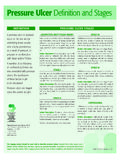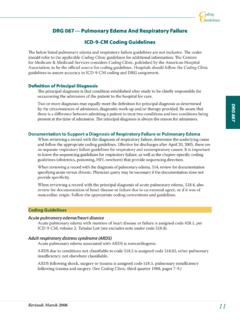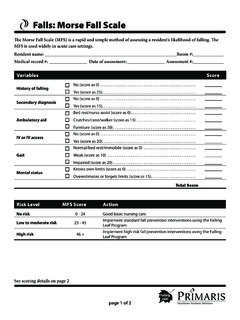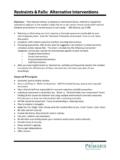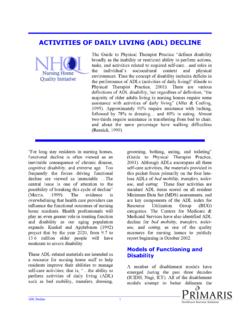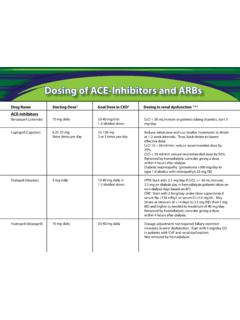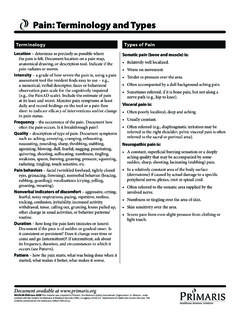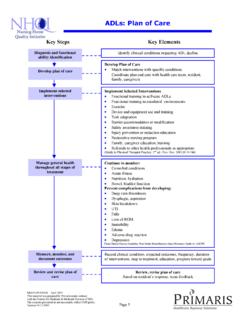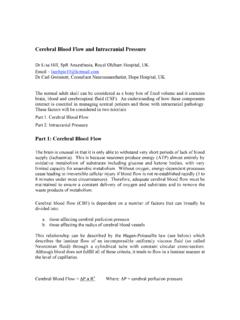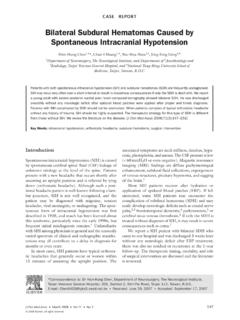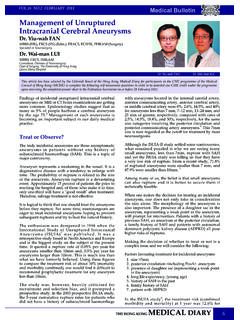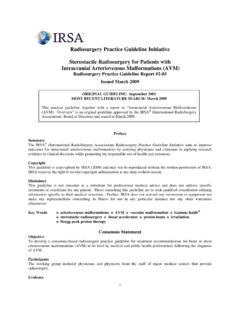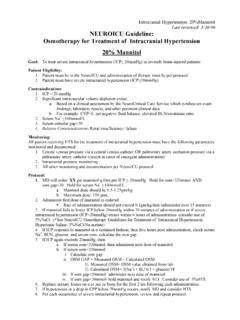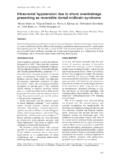Transcription of DRG 014 — Intracranial Hemorrhage or Cerebral …
1 Odinguidelines odinguidelinesRevised: March 2006 DRG 014 DRG 559 DRG 014 intracranial hemorrhage or cerebral Infarction DRG 559 Acute Ischemic Stroke With Use of Thrombolytic Agent ICD-9-CM Coding Guidelines The below listed cerebrovascular disorder guidelines are not inclusive. The coder should refer to the applicable Coding Clinic guidelines for additional information. The Centers for Medicare & Medicaid Services considers Coding Clinic, published by the American Hospital Association, to be the official source for coding guidelines. Hospitals should follow the Coding Clinic guidelines to assure accuracy in ICD-9-CM coding and DRG assignment. Definition of Principal Diagnosis The principal diagnosis is that condition established after study to be chiefly responsible for occasioning the admission of the patient to the hospital for care.
2 Two or more diagnoses may equally meet the definition for principal diagnosis as determined by the circumstances of admission, diagnostic work-up and/or therapy provided. Be aware that there is a difference between admitting a patient to treat two conditions and two conditions being present at the time of admission. The principal diagnosis is always the reason for admission. Documentation to Support Cerebrovascular Disorders When reviewing a medical record with the diagnosis of a cerebrovascular disorder, identify the medical record documentation that substantiates the cerebrovascular disorder. This may include: Sudden onset of acute severe headache Syncope, loss of consciousness, coma or stupor Fever, leukocytosis in conjunction with other signs and symptoms Vomiting, confusion, obtundation, dizziness in conjunction with other signs and symptoms Lethargy, delirium Seizures Stiffness in neck Sudden onset of a focal neurological deficit Sudden increase in Intracranial pressure Alteration in mental status Hypertension Hemiparesis Motor dysfunction Facial weakness, pain, numbness, hypoesthesia CT and MRI scans, brain Skull X-rays Cerebral angiography Lumbar puncture ECG EEG Ultrasound DRG 014 DRG 559 Revised.
3 March 2006 DRG 559, Acute ischemic stroke with use of thrombolytic agent DRG 559 was added FY 2006. This new DRG includes diagnosis codes and with procedure code , injection or infusion of thrombolytic agent. These are diagnosis codes included in DRG 14 unless procedure code is present. Coding Guidelines Acute Cerebral artery occlusion with infarction/hemiplegia/aphasia Codes 430 through 437 require the use of additional codes to identify any sequelae. For example, acute Cerebral artery occlusion with infarction with sequelae of hemiplegia and aphasia is assigned codes , and (See Coding Clinic, fourth quarter 1998, page 87.) Acute ischemic cerebrovascular accident with expressive aphasia and left-sided weakness Acute ischemic cerebrovascular accident is assigned code , Cerebral artery occlusion, unspecified, expressive aphasia is assigned code , aphasia, and left-sided weakness is assigned code , other malaise and fatigue.
4 (See Coding Clinic, fourth quarter 2004, pages 77 and 78.) Administration of neuroprotective agent As of October 1, 2000, code , administration of neuroprotective agent, was created. A neuroprotective agent is a product that works directly at the nerve cell level to minimize ischemic injury. Thrombolytic and neuroprotective agents are being used to minimize damage from a stroke. Nimotop (nimodipine) is being used to treat ischemic injury resulting from acute subarachnoid Hemorrhage . (See Coding Clinic, fourth quarter 2000, pages 68 and 69.) Brain stem stroke Brain stem stroke is assigned code , Cerebral artery occlusion, unspecified, with Cerebral infarction. (See Coding Clinic, fourth quarter 2004, pages 77 and 78.)
5 Code 436, acute, but ill-defined, cerebrovascular disease Never assign code 436 (stroke, CVA) when a more specific condition is documented. (See Coding Clinic, fourth quarter 1993, page 27.) Effective October 1, 2002, code 436 was included in redefined DRG 015. Effective October 1, 2004, stroke and CVA were no longer assigned code 436. They were re-indexed to the default code of When more definitive information is available, such as the stroke or CVA being embolic, , hemorrhagic, (430, 431, ) or thrombotic, , the more specific code should be assigned. Stroke and CVA are included in DRG 14. (See Coding Clinic, first quarter 2005, page 48 and Coding Clinic, fourth quarter 2004, pages 77-78.)
6 Codes 438/430-437 Prior to October 1, 1997, code 438 was not to be assigned with a current diagnosis from categories 430-437. (See Coding Clinic, first quarter 1993, page 27.) After September 30, 1997, code 438 was expanded with the use of fourth and fifth digits so new sequelae from a current stroke and residuals from a previous stroke could both be coded. (See Coding Clinic, second quarter 2002, page 35; Coding Clinic, fourth quarter 1998, pages 39 and 40; and Coding Clinic, fourth quarter 1997, pages 35-37.) Embolic hemorrhagic infarct of the temporal lobe Embolic hemorrhagic infarct of the temporal lobe is assigned code Hemorrhage is considered a component of the occlusion so code 431, intracerebral Hemorrhage , is not assigned as an additional code.
7 (See Coding Clinic, third quarter 1997, page 11.) odinguidelines odinguidelinesRevised: March 2006 DRG 014 DRG 559 Facial weakness/droop Facial weakness due to a late effect of cerebrovascular accident is assigned code Facial weakness not due to a late effect of cerebrovascular disease is assigned code , facial weakness. (See Coding Clinic, fourth quarter 2003, page 72.) Fifth digits for categories 433 and 434 Fifth digits must modify the fourth digit to which they are applied. They must follow a logical hierarchical structure. The fifth-digits 0 without mention of Cerebral infarction and 1 with Cerebral infarction, apply only to the code to which they are fifth digit of 1 (with Cerebral infarction) is only assigned for the admission during which the infarction occurs.
8 (See Coding Clinic, second quarter 1995, page 16.) History of a CVA When there is a history of CVA and no residuals are present, assign code When there is a history of CVA and there are residuals present, assign the appropriate codes from category 438. (See Coding Clinic, fourth quarter 1998, pages 88 and 89, and Coding Clinic, fourth quarter 1997, page 37.) Hypertensive cerebrovascular disease First assign codes from 430-438, cerebrovascular disease, then the appropriate hypertension code from categories 401-405 unless there is a specific code for the hypertensive condition, , hypertensive encephalopathy, (See Coding Clinic, third quarter 1990, page 3.) Lacunar infarction An acute lacunar infarction is assigned code (See Coding Clinic, second quarter 1996, page 5.)
9 Late effects of cerebrovascular disease There were major modifications to category 438 that became effective for discharges on and after October 1, 1997. Category 438, late effects of cerebrovascular disease, was expanded to four or five digit codes. This was done so specific late effect deficits could be identified, as well as a current diagnosis from categories 430-437 and any new sequelae. (See Coding Clinic, fourth quarter 1997, pages 35, 36, 59 and 60.) The residual effect is a secondary diagnosis. For example, contractures of the right and left wrist due to a previous stroke are assigned codes and (See Coding Clinic, fourth quarter 1998, pages 39 and 40.) A history of Cerebral artery occlusion with infarction with residuals of hemiplegia and aphasia is assigned codes and (See Coding Clinic, fourth quarter 1998, pages 39 and 40.)
10 If this was an admission for an acute Cerebral infarction with hemiplegia and aphasia, the correct codes would be , Cerebral artery occlusion, unspecified, with Cerebral infarction as the principal diagnosis, plus codes , hemiplegia, unspecified, and , aphasia. (See Coding Clinic, fourth quarter 1998, page 87.) A patient was admitted to a skilled nursing facility for intensive physical therapy rehabilitation following hospital treatment for a stroke. Rehabilitation was for severe ataxia and blurred vision due to the stroke. Code , other physical therapy, is sequenced as the principal diagnosis. Blurred vision, late effects of cerebrovascular disease, , disturbances of vision, other specified visual disturbances, and ataxia, , late effects of cerebrovascular disease, ataxia are sequenced as secondary diagnoses.

